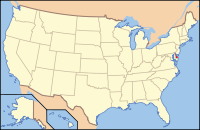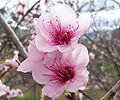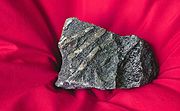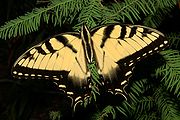
List of Delaware state symbols
Encyclopedia
The following Delaware state symbols have been approved by the Delaware General Assembly and added to the Delaware Code:

{| class="toccolours" style="float:right; clear:right; width:300px;
|+ style="font-size: large; margin: inherit;"|
|-
|Colors|| Colonial Blue and Buff
|-
|Motto|| Liberty and Independence
|-
|Song||Our Delaware
|-
|Bird|| Blue Hen Chicken
|-
|Tree|| American Holly
|-
|Flower|| Peach Blossom
|-
|Bug|| Lady Bug
|-
|Mineral|| Sillimanite
|-
|Fish|| Weakfish
|-
|Beverage|| Milk
|-
|Herb|| Sweet goldenrod
|-
|Fossil|| Belemnite
|-
|Butterfly|| Tiger swallowtail
|-
|Soil|| Greenwich Loam
|-
|Dessert|| Peach Pie
|-
|Star|| Delaware Diamond
|-
|Marine Animal|| Horseshoe crab
|-
|Macroinvertebrate|| Stonefly
|}
 The seal of Delaware
The seal of Delaware
was first adopted on January 17, 1777, with the current version being adopted April 29, 2004. It contains the state coat of arms surrounded by the inscription "Great Seal of the State of Delaware" and the dates 1704, 1776 and 1787.
 The flag of Delaware
The flag of Delaware
was first adopted on July 24, 1913. It consists of a buff-colored
diamond on a field of colonial blue, with the coat of arms
of the state of Delaware inside the diamond. Below the diamond, the date December 7, 1787, declares the day on which Delaware became the first state to ratify the United States Constitution
. The colors of the flag reflect the colors of the uniform of General George Washington
.
.
" was first adopted in 1925. It is a poem containing three verses written by George B. Hynson, a fourth verse written by Donn Devine, and a musical score composed by Will M. S. Brown.

was officially adopted on April 14, 1939, having been used as many political campaigns and publications.


was officially adopted on May 9, 1895, in recognition of peach tree orchards yielding thousands of dollars worth of crop worth at that time.

was officially adopted April 25, 1974, at the suggestion of Mollie Brown-Rust's 2nd grade class at the Lulu M. Ross Elementary School in Milford, Delaware
.

was recognized by geologists in Delaware prior to 1830, is widespread throughout the schists of the Delaware Piedmont, and occurs as large masses and steam-rounded boulders at the Brandywine Springs State Park.
was officially adopted in 1981 in recognition of its values as a game and food fish.
was officially adopted on June 3, 1983.
(Solidago odora) was officially adopted June 24, 1996, as indigenous to the state, commonly found in coastal areas and along the edges of marshes and thickets.

. The fossil, an extinct squid with a conical shell, is commonly found along the Chesapeake and Delaware Canal
.

(Pterourus glaucus) was officially adopted on June 10, 1999, as indigenous to Delaware and commonly found in deciduous woods, along streams, rivers, and wooded swamps, and in towns and cities throughout Delaware. They were chosen based on a statewide vote of public and parochial students, out of suggestions from students of the Richardson Park Learning Center.
was officially adopted on April 20, 2000, as commonly found in all counties in Delaware and enhancing water quality, agriculture, wildlife habitat, and natural landscape
beauty.
(coordinates of right ascension 9h40m44s and declination 48°14’2”) was officially adopted on June 30, 2000, as a star of the 12th magnitude and the first star on the International Star Registry
ever to be registered to an American State. It was chosen in a 1999 Delaware Museum of Natural History contest by Amy Nerlinger of Wilmington.
(Limulus polyphemus) was officially adopted on June 25, 2002, in recognition its importance and value in the medical field and as the principal food source for over a million shore birds.
(Order Plecoptera) was officially adopted on May 4, 2005, in recognition of the importance of excellent water quality and the vital role played by healthy aquatic ecosystems. It was supported by Gunning-Bedford Middle School, Salesianum High School, Delcastle Technical High School, Dickinson High School Environmental Club, The Independence School, Springer Middle School, St. Andrews School, and The Charter School of Wilmington.

|+ style="font-size: large; margin: inherit;"|
|-
|Colors|| Colonial Blue and Buff
|-
|Motto|| Liberty and Independence
|-
|Song||Our Delaware
Our Delaware
Our Delaware is a poem written by George Beswick Hynson, published in 1906. It comprises three verses, each honoring one of Delaware's three counties, with the fourth verse added by Donn Devine commemorating the American Revolution Bicentennial in 1976. It became the state song in 1925 by an act...
|-
|Bird|| Blue Hen Chicken
Blue Hen Chicken
The Blue Hen of Delaware is a variety of chicken that was adopted on April 14, 1939, as the state bird of Delaware. The University of Delaware mascot, known as YoUDee, is also modeled after the bird....
|-
|Tree|| American Holly
|-
|Flower|| Peach Blossom
Peach
The peach tree is a deciduous tree growing to tall and 6 in. in diameter, belonging to the subfamily Prunoideae of the family Rosaceae. It bears an edible juicy fruit called a peach...
|-
|Bug|| Lady Bug
Coccinellidae
Coccinellidae is a family of beetles, known variously as ladybirds , or ladybugs . Scientists increasingly prefer the names ladybird beetles or lady beetles as these insects are not true bugs...
|-
|Mineral|| Sillimanite
Sillimanite
Sillimanite is an alumino-silicate mineral with the chemical formula Al2SiO5. Sillimanite is named after the American chemist Benjamin Silliman . It was first described in 1824 for an occurrence in Chester, Middlesex County, Connecticut, USA....
|-
|Fish|| Weakfish
Weakfish
The weakfish, Cynoscion regalis, is a marine fish of the drum family Sciaenidae.The head and back of this fish are dark brown in color with a greenish tinge. The sides have a faint silvery hue with dusky specks, and the belly is white. The origin of its name is based on the weakness of the mouth...
|-
|Beverage|| Milk
Milk
Milk is a white liquid produced by the mammary glands of mammals. It is the primary source of nutrition for young mammals before they are able to digest other types of food. Early-lactation milk contains colostrum, which carries the mother's antibodies to the baby and can reduce the risk of many...
|-
|Herb|| Sweet goldenrod
Goldenrod
Solidago, commonly called goldenrods, is a genus of about 100 species of flowering plants in the family Asteraceae. Most are herbaceous perennial species found in the meadows and pastures, along roads, ditches and waste areas in North America. There are also a few species native to Mexico, South...
|-
|Fossil|| Belemnite
|-
|Butterfly|| Tiger swallowtail
Eastern tiger swallowtail
The Eastern Tiger Swallowtail is a species of swallowtail butterfly native to North America. It is one of the most familiar butterflies in the eastern United States, where it is common in many different habitats. It flies from spring to fall, during which it produces two to three broods...
|-
|Soil|| Greenwich Loam
Loam
Loam is soil composed of sand, silt, and clay in relatively even concentration . Loam soils generally contain more nutrients and humus than sandy soils, have better infiltration and drainage than silty soils, and are easier to till than clay soils...
|-
|Dessert|| Peach Pie
|-
|Star|| Delaware Diamond
Delaware Diamond
The official state star of Delaware is the Delaware Diamond, located in the constellation of Ursa Major , with coordinates of right ascension 9h 40m 44s and declination 48d 14' 2". The star was designated on June 30, 2000.-References:...
|-
|Marine Animal|| Horseshoe crab
Horseshoe crab
The Atlantic horseshoe crab, Limulus polyphemus, is a marine chelicerate arthropod. Despite its name, it is more closely related to spiders, ticks, and scorpions than to crabs. Horseshoe crabs are most commonly found in the Gulf of Mexico and along the northern Atlantic coast of North America...
|-
|Macroinvertebrate|| Stonefly
Plecoptera
Plecoptera are an order of insects, commonly known as stoneflies. There are some 3,500 described species worldwide, with new species still being discovered. Stoneflies are found worldwide, except Antarctica...
|}
Seal

Seal of Delaware
The Great Seal of the State of Delaware was first adopted on January 17, 1777, with the current version being adopted April 29, 2004. It contains the state coat of arms surrounded by an inscription.-Coat of arms:...
was first adopted on January 17, 1777, with the current version being adopted April 29, 2004. It contains the state coat of arms surrounded by the inscription "Great Seal of the State of Delaware" and the dates 1704, 1776 and 1787.
Flag

Flag of Delaware
The flag of the state of Delaware consists of a buff-colored diamond on a field of colonial blue, with the coat of arms of the state of Delaware inside the diamond. Below the diamond, the date December 7, 1787, declares the day on which Delaware became the first state to ratify the United States...
was first adopted on July 24, 1913. It consists of a buff-colored
Buff (colour)
Buff is a pale yellow-brown colour that got its name from the colour of buff leather.Displayed on the right is the colour buff.EtymologyAccording to the Oxford English Dictionary, buff as a descriptor of a colour was first used in the London Gazette of 1686, describing a uniform to be "A Red Coat...
diamond on a field of colonial blue, with the coat of arms
Seal of Delaware
The Great Seal of the State of Delaware was first adopted on January 17, 1777, with the current version being adopted April 29, 2004. It contains the state coat of arms surrounded by an inscription.-Coat of arms:...
of the state of Delaware inside the diamond. Below the diamond, the date December 7, 1787, declares the day on which Delaware became the first state to ratify the United States Constitution
United States Constitution
The Constitution of the United States is the supreme law of the United States of America. It is the framework for the organization of the United States government and for the relationship of the federal government with the states, citizens, and all people within the United States.The first three...
. The colors of the flag reflect the colors of the uniform of General George Washington
George Washington
George Washington was the dominant military and political leader of the new United States of America from 1775 to 1799. He led the American victory over Great Britain in the American Revolutionary War as commander-in-chief of the Continental Army from 1775 to 1783, and presided over the writing of...
.
Motto
"Liberty and Independence" was approved in 1847, and derived from the Order of CincinnatiSociety of the Cincinnati
The Society of the Cincinnati is a historical organization with branches in the United States and France founded in 1783 to preserve the ideals and fellowship of the American Revolutionary War officers and to pressure the government to honor pledges it had made to officers who fought for American...
.
Song
"Our DelawareOur Delaware
Our Delaware is a poem written by George Beswick Hynson, published in 1906. It comprises three verses, each honoring one of Delaware's three counties, with the fourth verse added by Donn Devine commemorating the American Revolution Bicentennial in 1976. It became the state song in 1925 by an act...
" was first adopted in 1925. It is a poem containing three verses written by George B. Hynson, a fourth verse written by Donn Devine, and a musical score composed by Will M. S. Brown.
The First State
This nickname was officially adopted on May 23, 2002, to commemorate the fact that on December 7, 1787, Delaware became the first of the 13 original states to ratify the U.S. Constitution.The Diamond State
This nickname comes from the legend that Thomas Jefferson described Delaware as a jewel among states due to its strategic location on the Eastern Seaboard.
Blue Hen State
This nickname comes from the fighting Blue Hen Cocks that were carried with soldiers for entertainment during the Revolutionary War.Small Wonder
This nickname comes from substantial contributions Delaware has made as compared to its relatively small size.Bird
The Blue Hen ChickenBlue Hen Chicken
The Blue Hen of Delaware is a variety of chicken that was adopted on April 14, 1939, as the state bird of Delaware. The University of Delaware mascot, known as YoUDee, is also modeled after the bird....
was officially adopted on April 14, 1939, having been used as many political campaigns and publications.

Tree
The American Holly (Ilex opaca Aiton) was officially adopted May 1, 1939, regarded as one of Delaware's most important forest trees.
Flower
The Peach BlossomPeach
The peach tree is a deciduous tree growing to tall and 6 in. in diameter, belonging to the subfamily Prunoideae of the family Rosaceae. It bears an edible juicy fruit called a peach...
was officially adopted on May 9, 1895, in recognition of peach tree orchards yielding thousands of dollars worth of crop worth at that time.

Bug
The Lady BugCoccinellidae
Coccinellidae is a family of beetles, known variously as ladybirds , or ladybugs . Scientists increasingly prefer the names ladybird beetles or lady beetles as these insects are not true bugs...
was officially adopted April 25, 1974, at the suggestion of Mollie Brown-Rust's 2nd grade class at the Lulu M. Ross Elementary School in Milford, Delaware
Milford, Delaware
Milford is a city in Kent and Sussex counties in the U.S. state of Delaware. According to the 2010 census, the population of the city is 9,559....
.

Mineral
SillimaniteSillimanite
Sillimanite is an alumino-silicate mineral with the chemical formula Al2SiO5. Sillimanite is named after the American chemist Benjamin Silliman . It was first described in 1824 for an occurrence in Chester, Middlesex County, Connecticut, USA....
was recognized by geologists in Delaware prior to 1830, is widespread throughout the schists of the Delaware Piedmont, and occurs as large masses and steam-rounded boulders at the Brandywine Springs State Park.
Fish
The WeakfishWeakfish
The weakfish, Cynoscion regalis, is a marine fish of the drum family Sciaenidae.The head and back of this fish are dark brown in color with a greenish tinge. The sides have a faint silvery hue with dusky specks, and the belly is white. The origin of its name is based on the weakness of the mouth...
was officially adopted in 1981 in recognition of its values as a game and food fish.
Beverage
MilkMilk
Milk is a white liquid produced by the mammary glands of mammals. It is the primary source of nutrition for young mammals before they are able to digest other types of food. Early-lactation milk contains colostrum, which carries the mother's antibodies to the baby and can reduce the risk of many...
was officially adopted on June 3, 1983.
Herb
Sweet goldenrodGoldenrod
Solidago, commonly called goldenrods, is a genus of about 100 species of flowering plants in the family Asteraceae. Most are herbaceous perennial species found in the meadows and pastures, along roads, ditches and waste areas in North America. There are also a few species native to Mexico, South...
(Solidago odora) was officially adopted June 24, 1996, as indigenous to the state, commonly found in coastal areas and along the edges of marshes and thickets.

Fossil
Belemnite was officially adopted on July 2, 1996, at the suggestion Kathy Tidball's third grade Quest students at Martin Luther King, Jr. Elementary School in Wilmington, DelawareWilmington, Delaware
Wilmington is the largest city in the state of Delaware, United States, and is located at the confluence of the Christina River and Brandywine Creek, near where the Christina flows into the Delaware River. It is the county seat of New Castle County and one of the major cities in the Delaware Valley...
. The fossil, an extinct squid with a conical shell, is commonly found along the Chesapeake and Delaware Canal
Chesapeake and Delaware Canal
The Chesapeake and Delaware Canal is a 14-mile long, 450-foot wide and 40-foot deep ship canal that cuts across the states of Maryland and Delaware, in the United States. It connects the waters of the Delaware River with those of the Chesapeake Bay and the Port of Baltimore...
.

Butterfly
The Eastern tiger swallowtailEastern tiger swallowtail
The Eastern Tiger Swallowtail is a species of swallowtail butterfly native to North America. It is one of the most familiar butterflies in the eastern United States, where it is common in many different habitats. It flies from spring to fall, during which it produces two to three broods...
(Pterourus glaucus) was officially adopted on June 10, 1999, as indigenous to Delaware and commonly found in deciduous woods, along streams, rivers, and wooded swamps, and in towns and cities throughout Delaware. They were chosen based on a statewide vote of public and parochial students, out of suggestions from students of the Richardson Park Learning Center.
Soil
Greenwich LoamLoam
Loam is soil composed of sand, silt, and clay in relatively even concentration . Loam soils generally contain more nutrients and humus than sandy soils, have better infiltration and drainage than silty soils, and are easier to till than clay soils...
was officially adopted on April 20, 2000, as commonly found in all counties in Delaware and enhancing water quality, agriculture, wildlife habitat, and natural landscape
Natural landscape
A natural landscape is a landscape that is unaffected by human activity. A natural landscape is intact when all living and nonliving elements are free to move and change. The nonliving elements distinguish a natural landscape from a wilderness. A wilderness includes areas within which natural...
beauty.
Star
The Delaware DiamondDelaware Diamond
The official state star of Delaware is the Delaware Diamond, located in the constellation of Ursa Major , with coordinates of right ascension 9h 40m 44s and declination 48d 14' 2". The star was designated on June 30, 2000.-References:...
(coordinates of right ascension 9h40m44s and declination 48°14’2”) was officially adopted on June 30, 2000, as a star of the 12th magnitude and the first star on the International Star Registry
International Star Registry
The International Star Registry , founded in 1979, is a company which sells products related to entries in the Your Place in the Cosmos book published by the company every 2 – 3 years. As of 2009, the company has produced 8 volumes of the book which includes customers from August 2004 through July...
ever to be registered to an American State. It was chosen in a 1999 Delaware Museum of Natural History contest by Amy Nerlinger of Wilmington.
Marine Animal
The Horseshoe crabHorseshoe crab
The Atlantic horseshoe crab, Limulus polyphemus, is a marine chelicerate arthropod. Despite its name, it is more closely related to spiders, ticks, and scorpions than to crabs. Horseshoe crabs are most commonly found in the Gulf of Mexico and along the northern Atlantic coast of North America...
(Limulus polyphemus) was officially adopted on June 25, 2002, in recognition its importance and value in the medical field and as the principal food source for over a million shore birds.
Macroinvertebrate
The StoneflyPlecoptera
Plecoptera are an order of insects, commonly known as stoneflies. There are some 3,500 described species worldwide, with new species still being discovered. Stoneflies are found worldwide, except Antarctica...
(Order Plecoptera) was officially adopted on May 4, 2005, in recognition of the importance of excellent water quality and the vital role played by healthy aquatic ecosystems. It was supported by Gunning-Bedford Middle School, Salesianum High School, Delcastle Technical High School, Dickinson High School Environmental Club, The Independence School, Springer Middle School, St. Andrews School, and The Charter School of Wilmington.
See also
- List of Delaware-related topics
- Lists of United States state insignia
- State of Delaware

